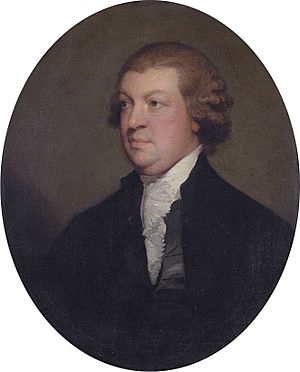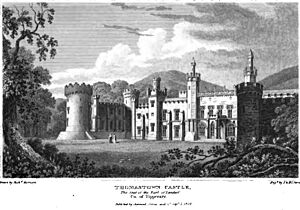John Scott, 1st Earl of Clonmell facts for kids
Quick facts for kids
John Scott
|
|
|---|---|
| Earl of Clonmell | |

John Scott, 1st Earl of Clonmel by Gilbert Stuart
|
|
| Born | 8 June 1739 |
| Died | 23 May 1798 (aged 58) |
John Scott, the 1st Earl of Clonmell (born June 8, 1739 – died May 23, 1798), was an important Irish lawyer and judge. He was also known as Lord Earlsfort and Viscount Clonmell during different times in his life. Some people called him "Copperfaced Jack." From 1784 until his death in 1798, he held a very high position as the Lord Chief Justice of the King's Bench for Ireland. This meant he was the main judge in one of Ireland's most important courts.
Contents
Early Life and Education
John Scott was born in County Tipperary, Ireland. He was the third son of Thomas Scott and Rachel Prim. His parents were cousins, and their families had a long history in the area.
John went to Kilkenny College for his schooling. While there, he became good friends with a boy named Hugh Carleton. Hugh's father, who was a wealthy and influential man in Cork, became a supporter of John. In 1756, Mr. Carleton helped both John and Hugh to study at Trinity College Dublin. After that, they continued their law studies in London at the Middle Temple.
In 1765, John Scott became a barrister, which is a type of lawyer who argues cases in court. He was very good at speaking, and this helped him succeed quickly. He even helped his patron, Francis Carleton, who was facing financial difficulties. John continued to support him until Hugh Carleton was able to take over the payments to his father. Later in life, John and Hugh's friendship became strained.
A Career in Law and Politics
In 1765, John Scott was allowed to practice law as a barrister. He soon entered politics and was elected as a Member of Parliament (MP) for Mullingar in 1769. He held this seat until 1783.
He quickly rose through the ranks in the legal world:
- In 1770, he became a King's Counsel (K.C.), a special title for experienced barristers.
- In 1772, he became a lawyer for the Board of Revenue, a job that paid very well.
- From 1774 to 1777, he served as Solicitor-General for Ireland, another important legal role.
- In 1777, he became a Privy Councillor and then the Attorney-General for Ireland, the chief legal advisor to the government.
In 1782, he was removed from his position as Attorney-General. This happened because he disagreed with England's right to make laws for Ireland. In 1775, he received an honorary Doctor of Law degree from Trinity College, Dublin. He also served as the Prime Serjeant-at-Law of Ireland from 1783 to 1784. He was also an MP for Portarlington from 1783 to 1784.
Becoming a Judge and Earl
In 1784, John Scott was made the 1st Baron Earlsfort. This happened after he was appointed Lord Chief Justice of Ireland, a very high judicial position. He continued to gain titles:
- In 1789, he became the 1st Viscount Clonmell.
- In 1793, he was made the 1st Earl of Clonmell.
By the 1790s, he had a very large income. He faced health challenges later in life, which may have contributed to his passing. He wrote in his diary about trying to live a healthier life, but it seems he found it difficult. His nickname "Copper-faced Jack" is still remembered today, even by a famous nightclub in Dublin.
John Scott was also interested in fencing. He is said to have inspired the idea for bayonet fencing in Ireland. A book about sword fighting, published in 1781, was even dedicated to him. As Attorney General, he publicly supported the idea of dueling if it was done honorably and for a good reason.
Life in Court
John Scott had a very strong personality in court. He sometimes treated other lawyers in a way that was not very polite. Once, his rudeness to a lawyer named Hackett led to a protest from other barristers. They decided not to appear in his court until he apologized, and he eventually did.
He often had disagreements with his fellow judges. He wanted to be in charge of his court, and after 1792, he largely achieved this.
In 1797, not long before he died, he had a conversation with his wife's cousin. He said that even though he had achieved great success as a Chief Justice and an Earl, he sometimes wished he was just starting out in life as a young chimney sweep. This shows that his high position came with its own difficulties. He passed away the following year, on May 23, 1798.
Legacy and Family
John Scott lived in Clonmell House on Harcourt Street in Dublin. He also had a country home called Temple Hill House in Blackrock, County Dublin. This house later became an orphanage and is now a private home. Clonmell Street and Earlsfort Terrace in Dublin are both named in his honor.
John Scott was married twice. In 1768, he married Catherine Anna Maria Roe, who passed away in 1771. In 1779, he married Margaret Lawless. They had a son, Thomas, who became his heir, and a daughter, Charlotte. Charlotte later married John Lygon, the 3rd Earl Beauchamp, but they did not have children.
His Character and Public View
Many people who knew John Scott had strong opinions about him. Some thought he was very ambitious and focused on his own success. His personal diary, which was published later, caused some controversy. It showed his critical views of some of his colleagues, including people who had been his friends.
John Scott was also a well-known figure in the memoirs of Judge Jonah Barrington and was often the subject of jokes by lawyer John Philpot Curran. A play called Copperfaced Jack was written about him in 1963. The popular Dublin nightclub, Copper Face Jacks, also takes its name from his nickname.
Images for kids
-
John Scott, 1st Earl of Clonmel by Gilbert Stuart



